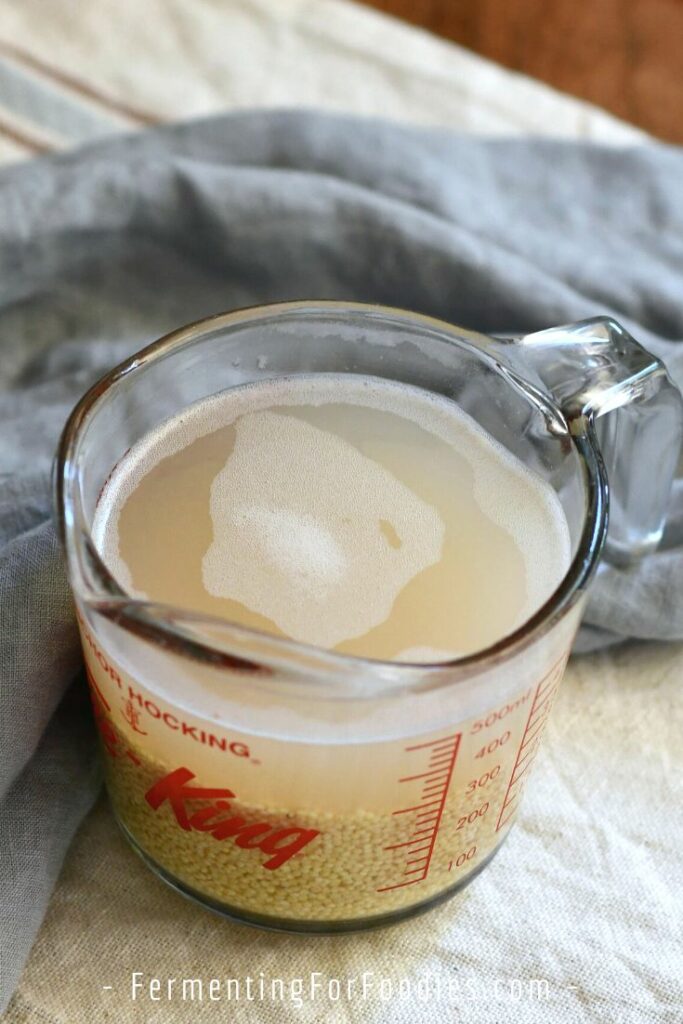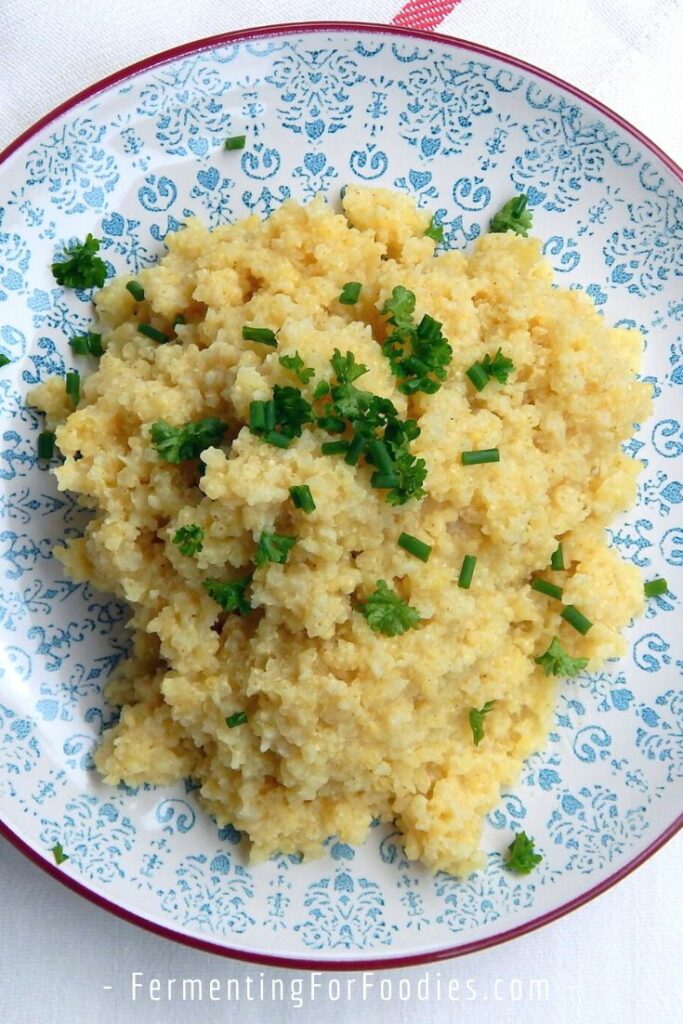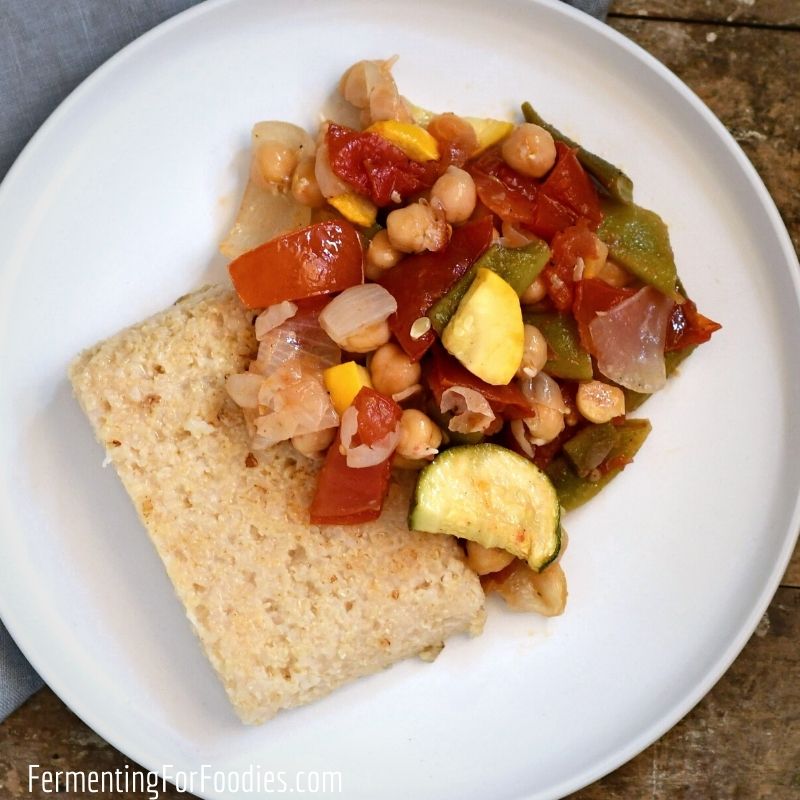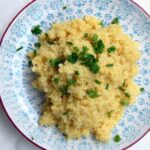Millet is one of those grains that naturally ferments, so making fermented millet is really easy! The fermentation reduces the cooking time, improves digestibility, and increases the nutritional value of this gluten-free grain.

In fact, fermented ground millet porridge, called ogi or uji, is a staple in a number of countries. Millet can also be fermented into a dosa batter or turned into rejuvelac.
This recipe for fermented millet is made with the whole grain, rather than ground millet. The result is a versatile delicious dish.

Serving Millet
I love millet. It is one of my favorite gluten-free grains. It is affordable, healthy, and very versatile. We use it as a replacement for polenta or rice.
Wondering what to do with millet?
Here are a few serving options:
- Enjoy it as a creamy hot porridge. It is delicious with fresh fruit and butter.
- Serve millet as a side dish, like grits. (See photo above).
- Make millet polenta. Fry it up and serve it with roasted vegetables and a rich tomato sauce. (See photo below).
- Press cooked millet into a pie plate and use it as a crust for a quiche. No pre-baking is required, simply let the millet cool into a firm crust before cooking your quiche.
- Use millet as a replacement for rice in risotto.
- Millet is a great gluten-free replacement for couscous. After cooking, rinse the millet with cool water so that the grains don’t stick together.

Simple Fermented Millet
This is a basic recipe for fermented millet that can be used as a base for all sorts of other dishes. See the section above for six different ways to serve millet.
- Cook Time: 15 min
- Total Time: 15 minutes
- Yield: 3 cups 1x
- Category: Side Dish
- Method: Fermented
- Cuisine: American
- Diet: Gluten Free
Ingredients
- 1 cup millet
- 1 1/2 cups filtered water (for fermenting)
- 2 Tbsp culture (optional, see notes)
- 2 1/2 cups water (for cooking)
- 1/2 tsp salt
- Additional flavors (see notes)
Instructions
Fermenting
- Mix the millet and water in a glass container for fermenting. You can add 2 Tbsp of culture to speed up the fermentation, or leave it to naturally ferment.
- Cover the container with a tea towel and leave it to ferment on the counter for 2-5 days. Stir with a clean fork once per day to encourage fermentation.
Cooking
- When you’re ready to cook the millet, drain off the fermenting liquid.
- Put drained millet and 2 1/2 cups of water into a pot and bring to a boil.
- Reduce the heat and simmer until all the liquid is absorbed (about 15 minutes).
- Stir in salt and any additional flavors (see notes for suggestions).
Notes
- An added culture is not necessary. Millet will naturally pick up a sourdough culture after about 3 days. However, if you want the fermentation to go quickly add 2 tablespoons of fermented liquid like kombucha or milk kefir.
- I recommend draining away the fermenting liquid and using fresh liquid for cooking. It helps to drain off the excess starch.
- Depending on how I’m going to serve the millet, I like to stir in a bit of flavor at the end of cooking. Just add flavors right after cooking as millet becomes thick and sticky as it cools.
- Adding a 1/4 cup of butter or oil will make a smooth and creamy cereal. It’s nice to add 1/4 cup of fresh chopped herbs or a few cloves of finely diced garlic for savory millet dishes.
Nutrition
- Serving Size: 1/2 cup cooked millet
- Calories: 378
- Sugar: 0g
- Sodium: 152mg
- Fat: 4.2g
- Saturated Fat: 0.7g
- Carbohydrates: 72.9g
- Fiber: 8.5g
- Protein: 11g
- Cholesterol: 0mg


HI Emillie,
I’m curious if cooking grains (or fruit or any fermented product) negates the health benefits of live bacteria gained from the fermentation process? Is it more easily digestible, or does it just add flavor when its cooked? Hope that makes sense…
You’re right. Cooking a fermented product does kill the probiotics. However, fermentation is good for breaking down complex carbs (like sourdough bread) and reducing sugars (like in dairy or fruit). I usually pre-ferment all grains because I find I digest prefermented grains more easily.
Hi Emillie,
I have been fermenting my own food a few years now and with a few other minor adjustment this has changed my life for the positive. I have just found your website while I was looking for instructions to ferment millet. I’m so excited for your site because you will ferment everything possible. Also for the past year after trying to make yogurt i instead started to make clabbered milk. Perfect food!
So not to make a short story to long I have been making sauerkraut for a while and have recently been adding garlic and onions which I really enjoy. My question to you is there a contradiction with fermenting an antibacterial garlic in a sauerkraut that is rich in bacteria? Have not found any answer.
Thank you for your time and as soon as I post this I will be making your sourdough pancake recipe for my little granddaughter. Stay happy! Stephen
I love your fermenting enthusiasm! I am currently fermenting garlic in honey (will post recipe in a month or two) and making black garlic. Both seem to ge going well, so I think that adding garlic to sauerkraut shouldn’t cause a problem for the bacteria. It might change the exact types of yeasts and bacteria, but not completely eliminate them.
Hello Emillie,
I want to start with saying that I love your website – it’s very inspiring!
I just discovered this when looking for options of fermented millet.
The reason I got interested in this is that I cooked some millet today and then had it sit in a glass jar. After ~12 hours, the grain smells delicious, reminds me strongly of Turkish Boza and a little bit of the estery aroma of Bavarian Hefe-Weizen beer.
I hesitate to eat it though. My question is – do you think this kind of fermentation, which happens after boiling unsoaked millet for 15 minutes, makes the same product like your recipe?
Thank you!
Thanks for the compliment!
I don’t know if it would be exactly the same… however, it sounds like you caught a sourdough-style starter. There are many different strains of yeasts and bacteria. Each of them like their own sorts of foods. My only concern with eating fermented grains that have sat out on the counter, is that they are a low-acid, low-salt ferment. So they may have undesirable cultures. If you heat it thoroughly, then you could probably safely taste it. You might even be able to use it to make a sourdough bread.
Cheers, Emillie
Can I imply from your reply, that adding salt and vinegar while cooking, as we do it for Tempeh, I can decrease the chance of unwanted yeast&bacteria?
I’ll definitely try to use this as a sourdough starter and see what happens – Thank you!
I’m hesitant to say yes… because I have never done it. Nor is that a traditional way of fermenting millet. Be careful if you decide to experiment.
I added some grape yeast water (fermented for 3 days) to cooked huled millet and also to puffed millet and after two days, neither developed any of the sour smell I got with cooked wheat or rye crackers after one day. I read millet takes longer to sour, three days for millet rather than two days for wheat. Is that your experience? Is adding the grape yeast water to raw millet better than adding it to cooked millet?
I usually ferment grains before cooking. I would expect that fermenting cooked millet with a starter would be very quick to ferment. The cooking would have made the sugars easily accessible, so lots for the culture to eat. 🙂
As for fermenting before or after cooking, it really depends on what you want to do with the millet. Fermenting then eating it as cereal or pudding is great! If you want the millet for something else, then ferment before cooking (which will take a few days). Cheers, Emillie
Hi, Emily As a point of comparison to your question, I’ll tell you that the Gujarati of India make a pancake from cooked then fermented rice. They eat it for breakfast. Google it for recipe . I made it myself and it is finger-licking good. Soo good! Good luck!
Interesting! I’ll have to look that up. I’ve made dosas, but that’s with raw rice, not cooked then fermented. Thanks for sharing!
I just found out about Ogi recently. I’m not sure if you are aware of the Indian version of fermenting millet, called ambali. They soak the grains for 6 – 8 hrs or overnight, cook for 20 minutes then let it sit for 6 hrs. I’ve tried this method once and on my second attempt I let the porridge sit for 24 and a separate container of the porridge sit for 48 hrs. Both came out great. I may try to let it ferment for 3 days but I think fermenting afterwards would be better if you are looking for probiotic benefits. I haven’t tried the Ogi method but will try it eventually.
I hadn’t heard of ambali. I will definitely check it out. Thanks for sharing!
Hi Emillie
What if we dont cook the millet but simply have the feremented water? Will that not be more beneficial. Like Rice Kanjee? Or have the fermented water and cook the millet in fresh water?
Just drinking the fermented millet water is fine. That would be very similar to the fermented beverage rejuvelac. And cooking the fermented millet in fresh water is fine as well. What a good idea to get a double benefit from your fermentation!
Hi Emilie, I’ve been wanting to try your gluten-free sourdough bread for a while, and this one for millet intrigues me because I love millet porridge because I love the Russian millet porridge I’ve had (though I have yet to come across a fermented version – on my list now). But my question today is about your replies to Sandro about safety. I’m in the process of fermenting some mung beans using fresh whey (I first sprouted and cooked them, as per the recommendations from Cultures for Health). They are in a glass jar in a warm cupboard (27 degrees C). They already have a nice smell after 12 hours in there. But is this kind of ferment safe to eat without cooking again? I didn’t use any salt or vinegar… they have only the whey. I wanted to eat them as porridge (without re-cooking) in order to get the live probiotics. But could I be getting “undesirable cultures” that way? Thanks!
Great! I’m glad to have inspired you!
I’m not entirely sure about that Cultures for Health recipe. It sounds like a variation on Rejuvelac… but adding whey is unusual. To be honest, I love Cultures For Health for their cultures… but I don’t think they always test their recipes. And because they don’t have a comments feature, I actually get a few people asking me questions about their recipes.
It is probably safe, but I’m hesitant to say 100% yes since it’s not a typical ferment, and I haven’t tested the recipe. Also, 27 C is really warm, which would increase the risks.
Hello, I am thrilled to have found your website! I appreaciate allllll the great content and thought out recipes within. In this recipe’s instruction section, the amount of water to cook the millet in is the same regardless of the scale that I choose (x1, x2, or x3). Could you please tell me the ratio of water to fermented millet to use? I can easily find the ratios for unfermented millet, but not fermented millet. Thank you
MY MISTAKE! I see that in the body of the recipe the amount of water for cooking changes based on the scale. I understand the the steps portion of the recipe refers to the x1 scale.
Great! The scaling up of the recipe is built into the recipe card and it doesn’t change the amounts in the instructions. Glad you figured it out!
I found your website looking for a millet polenta recipe. You have just a regular recipe which can be made with fermented or non-fermented millet. Does fermenting the millet change the way it tastes or change the texture? Or change the way it holds together? If it does change the flavor, how is it different? Which way would result in something closer to corn polenta?
It’s not necessary to ferment millet before making polenta. However, if you have trouble digesting grains, it may help. I have made my millet polenta with fermented millet and non-fermented millet. The texture is the same. However, fermenting will add a bit of tanginess to the flavor. Enjoy!
Hi Emillie, I can’t figure out whether you use unhulled or hulled millet in this recipe. I started fermenting the unhulled version with kombucha starter. No change on day 2. How do I know when it’s “fermented” please. By the way: exciting website!!!
Cheers Sigi
Definitely start with hulled millet. I don’t think unhulled millet is available for human consumption where I live. My understanding is that the hull is very hard and would definitely need to be removed before fermenting.
Many ferments don’t bubble actively like kombucha or sauerkraut. This is one of those recipes. Millet doesn’t have a lot of simple sugars to feed a bubbly ferment. The best way to tell if it’s done is by smell. Does it smell sour? Like kombucha, millet can be eaten when it’s lightly fermented (after 24 hours) or quite fermented. It really is up to you and what you would enjoy. 🙂
I’m glad you like my site! Cheers!
Thanks Emillie, too late, I used the unhulled version, which is available for human consumption here in New Zealand. Ok, I will cook it today then unfermented… The “whole grain” tripped me up. I actually much prefer hulled millet taste wise. But it’s not always available.
Cheers
Sigi
Ah… interesting. I’ve actually never seen hulled millet. It may have fermented through the hull, but I’ve never tried it. Cheers!
Thank you for this article. Millet helps balance my glucose. I am trying to eat it regularly. I find it a bit gritty, so I’m trying to see if I can ferment it and make it into flat bread. Have you tried using millet for bread?
I have used millet flour, but I haven’t used whole millet to bake bread. I like adding millet to baked goods to provide that crunch. You might also like this simple fermented millet as it cooks up into a soft, polenta-like meal. I sometimes let it firm up after cooking so I can fry it. However, if you have millet flour, it can be used like wholegrain flour in any of my gluten-free baked goods. For example, this flatbread: https://www.fermentingforfoodies.com/delicious-gluten-free-flatbread/
Cheers! Emillie